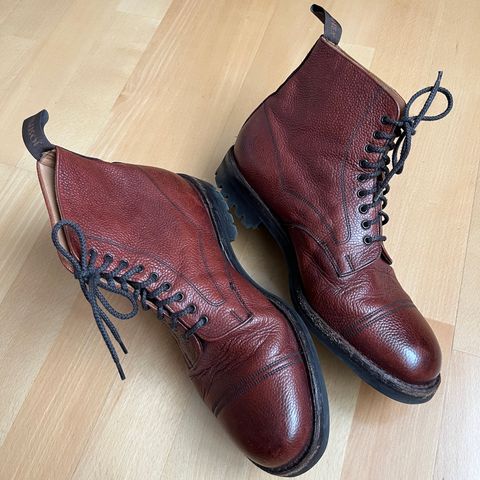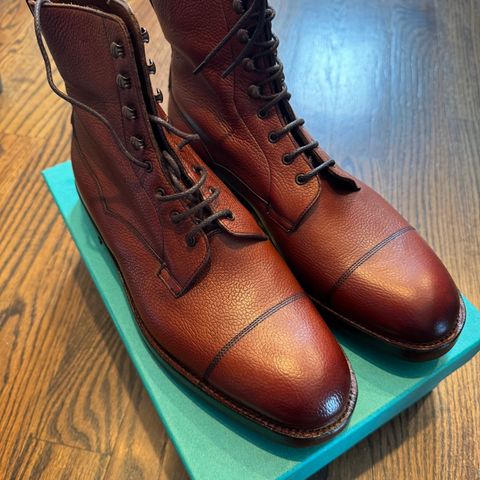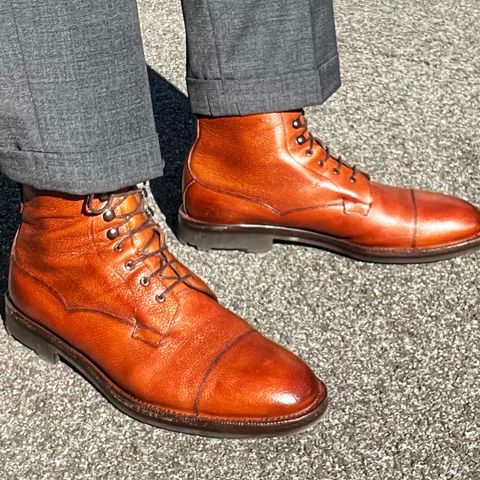Edward Green
MakerAbout
Edward Green is a British luxury footwear manufacturer established in 1890 in Northampton, England, specializing in Goodyear-welted dress shoes and boots. The company produces approximately 14,000 pairs annually through a workshop of 70 skilled craftspeople, maintaining founder Edward Green's principle of "excellence without compromise." The brand represents one of the most prestigious names in traditional English shoemaking, known for meticulous construction methods, refined lasts, and signature finishing techniques including leather antiquing and burnishing.
About
Edward Green is a British luxury footwear manufacturer established in 1890 in Northampton, England, specializing in Goodyear-welted dress shoes and boots. The company produces approximately 14,000 pairs annually through a workshop of 70 skilled craftspeople, maintaining founder Edward Green's principle of "excellence without compromise." The brand represents one of the most prestigious names in traditional English shoemaking, known for meticulous construction methods, refined lasts, and signature finishing techniques including leather antiquing and burnishing.
History
Edward Green founded his shoemaking workshop in Northampton in 1890 after beginning his career as a twelve-year-old apprentice in the footwear trade. He assembled the town's most skilled craftsmen and sourced superior materials, establishing a reputation for elite artisanship through English Goodyear-welted footwear that rejected the mass production trends of the Industrial Revolution.
By the 1930s, under the direction of Green's sons, the company served notable clientele including Ernest Hemingway, Edward Duke of Windsor, and Cole Porter. During this period, the firm became the largest manufacturer of officers' boots for the British Army, demonstrating its capacity for both refined civilian footwear and military specifications.
Following World War II, the company transitioned from boots to shoes as its primary focus. Financial difficulties in 1982 led to acquisition by John Hlustik, a Czech emigré shoe designer who trained in Italy and Spain. Hlustik restored the firm's emphasis on uncompromising quality while introducing European refinement to Northampton traditions, pioneering techniques of burnishing and antiquing leather. He championed brown shoes to showcase fine calf leather and expanded the company internationally through boutiques in London's Burlington Arcade, New York, Tokyo, Paris, and Hong Kong.
The company relocated from Northampton's historic boot-making quarter to a modern facility prioritizing contemporary manufacturing standards. This expansion included new workshops while maintaining the traditional craftsmanship that defined the brand's reputation.
Manufacturing
Edward Green operates from Northampton, producing no more than 325 pairs weekly through approximately 70 skilled artisans. The company employs traditional Goodyear-welt construction, a technique associated with English shoemaking wherein a strip of leather or rubber is sewn around the bottom edge, attaching the uppers, insole, and sole together. The majority of shoes are welted using specialized machinery, though some models incorporate hand-stitching.
The production process begins in the clicking room, where master craftsmen select only perfect leather portions. A single calfskin yields material for merely two or three pairs of uppers, with rejected sections showing imperceptible texture variations. Individual workers construct complete uppers rather than performing repetitive single tasks, with each upper receiving twelve stitches per inch at micrometer accuracy. The company reinforces shoe sides using carefully skived leather pieces, a technique extending longevity beyond standard construction.
A distinctive older lasting machine operated by three-person teams draws leather tighter and more smoothly than modern single-operator equipment. Following lasting, workers hand-beat uppers to remove irregularities before allowing slow drying. Norwegian uppers feature hand-stitching using pig bristle rather than needles, creating smaller openings and superior aesthetics.
The Goodyear-welted construction includes a closed channel concealing welt stitches, a refinement distinguishing Edward Green footwear. Materials include German sole leather and Italian calf, with finishing processes creating distinctive patina through burnishing and antiquing. Each shoe carries a handwritten label with unique identification numbers enabling lifelong traceability, with the factory maintaining photographic archives of repairs on shoes twenty to thirty years old.
Products
Edward Green produces dress shoes and boots across multiple proprietary lasts, each offering distinct fit characteristics and aesthetic profiles. The company describes itself as custodian of British shoemaking tradition, balancing timeless design with subtle evolution.
The Chelsea, originating in the 1930s, represents the company's most popular model—a cap-toe oxford adorned with signature swan's neck stitching. Available on multiple lasts including the 202 and 82, the design serves as a formal business shoe emphasizing elegance and sophistication. The 202 last features a rounded toe and comfortable fit, while the 82 last presents a slimmer toe for contemporary appeal.
The Dover serves as the company's split-toe derby, hand-sewn with boar bristle and particularly favored among footwear enthusiasts. This model demonstrates the company's commitment to traditional construction methods in casual dress shoe designs.
The Galway represents Edward Green's interpretation of a country boot, available on the 82, 202, and chunky 64 lasts. Versions include utah delapre leather with Dainite rubber soles for urban wear, or contrasting suede and calf combinations emphasizing sophistication. The boot demonstrates the company's range beyond formal dress shoes while maintaining construction standards.
Additional models include various chelsea boots and derbies constructed using the same techniques and materials as the signature offerings. All production emphasizes fine calfskin and occasional exotic hides including deerskin, stingray, and crocodile.





























































